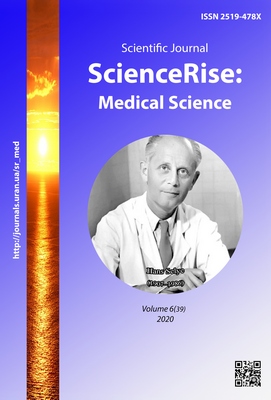Endothelium condition and role of immunocompetent cells in atherosclerosis development as a cause of ischemic stroke
DOI:
https://doi.org/10.15587/2519-4798.2020.220202Keywords:
atherosclerosis, endothelium, immunocompetent cells, macrophages, lymphocytes, ischemic stroke, CD4, CD8, CD20, CD68, CD31Abstract
The aim. To determine the state of the cerebral vascular endothelium and the role of immunocompetent cells in the ischemic stroke development on the background of atherosclerosis.
Materials and methods. We studied cerebral vessels of 50 deaths with ischemic cerebral infarctions, 50 – with severe cerebral atherosclerosis without CVD (cerebrovascular disease) manifestation and 50 deaths, whose cause of death was not related to CVD and atherosclerosis (control group). Histological preparations of vessels were stained with hematoxylin-eosin and Masson Trichrome, and also immunohistochemical study was conducted using CD31/PECAM-1 (Endothelial Cell Marker) Ab-1, CD4 (CD4 Ab-8), CD8 (SP 16), CD20 (CD20 Ab-1) CD68 and (CD68/Macrophage Marker Ab-4) markers.
Results. Under ischemic strokes and severe atherosclerosis the cerebral vessels endothelium acquires structural changes in form of rupture, desquamation and exfoliation, formation of desquamated endothelial cells clusters. Speaking of endothelial damage, it should not be supposed that changes should occur at the macroscopic level only, endothelial damage at the cellular level shall be sufficient enough. Immunocompetent cells are of key importance in atherosclerosis development; adhesion on the luminal surface of arteries, presence of a large number of these cells under the endothelium and of more mature macrophages in the intima depth indicates the influx of these cells, which actively potentiate atherosclerosis formation, from the blood into the artery wall.
Conclusions. Disorders of the endothelial lining with changes in endothelial cells morphology contribute to the atherosclerotic plaque development. Lymphocytes and macrophages form the molecular basis of many important processes, including the inflammatory response and the immune response
References
- Zinchenko, O. M., Mishchenko, T. S. (2016). Stan nevrolohichnoi sluzhby v Ukraini v 2015 rotsi. Kharkiv, 23.
- Zozulia, I. S., Zozulia, A. I. (2011). Epidemiolohiia tserebrovaskuliarnykh zakhvoriuvan v Ukraini. Ukrainskyi medychnyi chasopys, 5, 38–41.
- Mishchenko, T. S. (2010). Analiz epidemiolohii tserebrovaskuliarnykh khvorob v Ukraini. Sudynni zakhvoriuvannia holovnoho mozku, 3, 2–11.
- Mischenko, T. S. (2017). Epidemiologiia tserebrovaskuliarnykh zabolevanii i organizatsiia pomoschi bolnym s mozgovym insultom v Ukraine. Ukrainskii vіsnik psikhonevrologіi, 25 (90), 22–24.
- Moshenska, O. P. (2011). Fatalnyi ishemichnyi insult: osoblyvosti naihostrishoho periodu. Ukrainskyi medychnyi chasopys, 1 (81), 29–35.
- Fartushna, O. Ye., Vinychuk, S. M. (2015). Vyiavlennia ta usunennia vaskuliarnykh chynnykiv ryzyku – vazhlyvyi napriamok pervynnoi profilaktyky tranzytornykh ishemichnykh atak ta/chy insultu. Ukrainskyi medychnyi chasopys, 1, (105), 23–27.
- Bobryshev, Iu. V., Karagodin, V. N., Kovalevskaia, Zh. I. et. al. (2010). Kletochnye mekhanizmy ateroskleroza: vrozhdennii immunitet i vospalenie. Fundamentalnye nauki i praktika, 1 (4), 140–148.
- Shimada, K. (2009). Immune system and atherosclerotic disease. Heterogeneity of Leukocyte Subsets Participating in the Pathogenesis of Atherosclerosis. Circulation Journal, 73 (6), 994–1001. doi: http://doi.org/10.1253/circj.cj-09-0277
- Gotsman, I., Gupta, R., Lichtman, A. H. (2007). The Influence of the Regulatory T Lymphocytes on Atherosclerosis. Arteriosclerosis, Thrombosis, and Vascular Biology, 27 (12), 2493–2495. doi: http://doi.org/10.1161/atvbaha.107.153064
- Schafer, A., Bauersachs, J. (2008). Endothelial Dysfunction, Impaired Endogenous Platelet Inhibition and Platelet Activation in Diabetes and Atherosclerosis. Current Vascular Pharmacology, 6 (1), 52–60. doi: http://doi.org/10.2174/157016108783331295
- George, A. L., Bangalore-Prakash, P., Rajoria, S., Suriano, R., Shanmugam, A., Mittelman, A., Tiwari, R. K. (2011). Endothelial progenitor cell biology in disease and tissue regeneration. Journal of Hematology & Oncology, 4 (1), 24. doi: http://doi.org/10.1186/1756-8722-4-24
- Münzel, T., Sinning, C., Post, F., Warnholtz, A., Schulz, E. (2008). Pathophysiology, diagnosis and prognostic implications of endothelial dysfunction. Annals of Medicine, 40 (3), 180–196. doi: http://doi.org/10.1080/07853890701854702
- Ammirati, E., Moroni, F., Magnoni, M., Camici, P. G. (2015). The role of T and B cells in human atherosclerosis and atherothrombosis. Clinical & Experimental Immunology, 179 (2), 173–187. doi: http://doi.org/10.1111/cei.12477
- Jones Buie, J. N., Oates, J. C. (2014). Role of Interferon Alpha in Endothelial Dysfunction: Insights Into Endothelial Nitric Oxide Synthase–Related Mechanisms. The American Journal of the Medical Sciences, 348 (2), 168–175. doi: http://doi.org/10.1097/maj.0000000000000284
- Vanhoutte, P. M. (2009). Endothelial Dysfunction. Circulation Journal, 73 (4), 595–601. doi: http://doi.org/10.1253/circj.cj-08-1169
- Regina, C., Panatta, E., Candi, E., Melino, G., Amelio, I., Balistreri, C. R. et. al. (2016). Vascular ageing and endothelial cell senescence: Molecular mechanisms of physiology and diseases. Mechanisms of Ageing and Development, 159, 14–21. doi: http://doi.org/10.1016/j.mad.2016.05.003
Downloads
Published
How to Cite
Issue
Section
License
Copyright (c) 2020 Nataliia Chuiko

This work is licensed under a Creative Commons Attribution 4.0 International License.
Our journal abides by the Creative Commons CC BY copyright rights and permissions for open access journals.
Authors, who are published in this journal, agree to the following conditions:
1. The authors reserve the right to authorship of the work and pass the first publication right of this work to the journal under the terms of a Creative Commons CC BY, which allows others to freely distribute the published research with the obligatory reference to the authors of the original work and the first publication of the work in this journal.
2. The authors have the right to conclude separate supplement agreements that relate to non-exclusive work distribution in the form in which it has been published by the journal (for example, to upload the work to the online storage of the journal or publish it as part of a monograph), provided that the reference to the first publication of the work in this journal is included.









